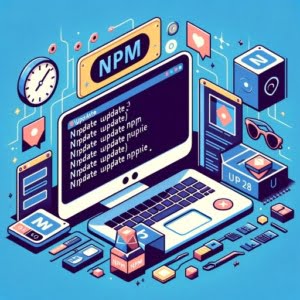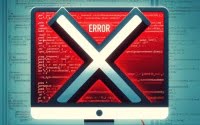NPM Update Guide | Keep Node.js Dependencies Current

Ever felt overwhelmed trying to keep your Node.js dependencies up-to-date? At IOFLOOD, we’re no strangers to this task. That’s why we’ve crafted a guide on npm update. By following our step-by-step instructions, you’ll effortlessly ensure that your project’s dependencies are always current, minimizing compatibility issues.
This guide will walk you through the npm update command, helping you maintain your project with the latest and greatest versions of its dependencies. By the end of this journey, you’ll understand how to use npm update effectively as well as its significance in keeping your Node.js projects healthy and up-to-speed.
Let’s embark on this journey together and keep our Node.js projects running smoothly!
TL;DR: How Do I Update All My Project Packages to the Latest Version Using npm?
To update all packages in your Node.js project to their latest versions, simply run the
npm updatecommand in your project directory.
Here’s a quick example:
npm update
This command sifts through all the packages listed in your project’s package.json file and updates them to their latest versions, considering the version constraints specified. It’s a straightforward yet powerful way to ensure your dependencies are up-to-date.
Dive deeper into this guide for more detailed instructions, troubleshooting tips, and to explore advanced usage of the
npm updatecommand. Your Node.js project deserves the latest and greatest from the vast npm ecosystem.
Table of Contents
Beginner’s Guide to npm Update
When you’re just getting started with Node.js, managing project dependencies might seem daunting. However, npm update simplifies this process, ensuring your packages are current yet compatible with your project’s requirements. Let’s break down how to use this command effectively.
Updating Within Semver Constraints
Semantic Versioning (semver) is a rule-based system that npm follows to manage package versions. It helps in understanding the type of changes in each version update. Here’s how you can update your dependencies within these semver constraints:
npm update sample-package
# Output:
# + [email protected]
# updated 1 package in 0.567s
In the above example, sample-package is updated to the latest version that complies with the version constraints specified in your package.json. This ensures that your project doesn’t break due to incompatible updates.
The Role of package-lock.json
The package-lock.json file plays a crucial role in dependency management. It locks your project’s dependencies to specific versions, ensuring that everyone working on the project has the same environment. This file is automatically updated when you run npm update, reflecting the latest compatible versions of your dependencies.
Understanding the balance between updating packages and maintaining compatibility is key to a healthy Node.js project. With npm update, you’re taking a significant step towards achieving that balance, ensuring your project stays up-to-date and secure.
Advanced npm Update Techniques
As you grow more comfortable with managing Node.js dependencies, npm update offers advanced features to fine-tune your project. Let’s explore how to update global packages, use tags for version specificity, and leverage semantic versioning to its fullest.
Updating Global Packages
Global packages are installed system-wide and are accessible from any directory. To update these packages, you’ll need to add the -g or --global flag. Here’s how you can update a global package:
npm update -g specific-package
# Output:
# + [email protected]
# updated 1 package in 1.234s
This command updates specific-package to the latest version available globally. It’s essential for tools and utilities you use across multiple projects.
Using Tags to Specify Versions
npm allows the use of tags to specify package versions, which can be particularly useful for beta or test versions. Here’s an example of updating a package to a tagged version:
npm update sample-package@next
# Output:
# + [email protected]
# updated 1 package in 0.789s
In this scenario, sample-package is updated to the latest beta version tagged as next. This approach is beneficial when you want to test new features of a package before they are officially released.
Semantic Versioning Deep Dive
Semantic Versioning (semver) is at the heart of npm’s version management. Understanding semver helps you make informed decisions about updating your dependencies. For instance, updating to a major version might introduce breaking changes, while minor and patch updates usually offer backward compatibility.
By mastering these advanced npm update techniques, you’re equipped to manage your Node.js dependencies with precision, ensuring your projects remain robust, secure, and at the cutting edge.
Other Strategies| npm Management
For those who have mastered the basics of npm update and are ready to explore more nuanced strategies for managing Node.js dependencies, there are several alternative approaches worth considering. Let’s dive into using npm ci, leveraging npx, and the art of manual edits in the package.json file for precise version control.
Clean Installs with npm ci
When consistency across installations is paramount, npm ci is your go-to command. It performs a clean installation of your project dependencies based on the package-lock.json file, ignoring the package.json if there are discrepancies. This ensures that you get the exact versions of dependencies that were last committed to your repository.
npm ci
# Output:
# added 123 packages in 4.567s
The above command reinstalls dependencies ensuring your environment mirrors your last stable build. This is especially useful in continuous integration environments where predictability is key.
Running Packages with npx
npx allows you to run packages without installing them globally. It’s particularly handy for running packages that you use occasionally or testing different versions of a package without affecting your global or project-specific installations.
npx some-package@latest --version
# Output:
# 2.3.4
In this example, npx executes some-package at its latest version, displaying the version number. This method offers flexibility and reduces global package clutter.
Manual Edits for Specific Version Control
There are times when auto-updating doesn’t align with your project’s needs, and manual intervention becomes necessary. Editing the package.json file allows for precise control over package versions, enabling you to specify exact versions or ranges that suit your project’s requirements.
"dependencies": {
"example-package": "^1.2.3"
}
Manually updating the version number in package.json and running npm install afterwards ensures that you get the specified version, offering a balance between control and automation.
By incorporating these expert-level strategies into your dependency management workflow, you gain greater control and flexibility over your Node.js project’s ecosystem. Whether you’re aiming for consistency, testing, or precise version control, these alternative approaches provide the tools you need to manage your dependencies effectively.
Even with the best intentions, updating Node.js project dependencies using npm update can sometimes lead to unexpected issues. Understanding how to troubleshoot common problems and considering best practices can save you from potential headaches down the line.
Handling Unmet Peer Dependencies
Peer dependencies are packages that your project depends on, but you don’t directly control. When npm update leads to unmet peer dependencies, it’s usually because the update doesn’t meet the required versions specified by your project’s direct dependencies.
npm list
# Output:
# UNMET PEER DEPENDENCY [email protected]
The output highlights packages with unmet peer dependencies. To resolve this, you might need to manually update the conflicting packages to versions that satisfy all peer dependency requirements.
Resolving Version Conflicts
Version conflicts occur when two or more dependencies require different versions of the same package. This can prevent npm update from successfully updating your project’s dependencies.
npm outdated
# Output:
# Package Current Wanted Latest Location
# conflicting-pkg 2.3.4 2.3.5 3.0.0 your_project
Using npm outdated, you can identify the packages that are behind their desired versions. To resolve conflicts, consider updating the dependencies individually or adjusting the version ranges in your package.json to accommodate the updates.
Reverting an Update
Sometimes, an update may introduce issues to your project. Knowing how to revert changes made by npm update is crucial.
git checkout -- package-lock.json
npm install
This approach uses Git to revert the package-lock.json file to its previous state and then runs npm install to synchronize the node_modules directory with the reverted package-lock.json. It’s a safe way to roll back an update while investigating the cause of the issue.
Maintaining a Healthy Dependency Tree
Keeping your project’s dependency tree healthy is about more than just updating; it involves careful consideration of each update’s impact. Regularly reviewing and auditing your dependencies with npm audit can help identify and mitigate security vulnerabilities. Additionally, staying informed about major updates to your dependencies and testing updates in a controlled environment can prevent unforeseen issues.
By adopting these troubleshooting strategies and considerations, you can navigate the complexities of managing Node.js dependencies with npm update, ensuring your projects remain robust and reliable.
npm: The Node.js Lifeline
Understanding the backbone of Node.js project dependency management begins with npm, the Node Package Manager. It’s more than just a tool; it’s the lifeline for developers to share and consume code, ensuring projects remain functional and up-to-date.
The Heart: package.json
The package.json file is the heart of any Node.js project. It’s where you declare your project’s dependencies, scripts, and much more. Think of it as the blueprint of your project’s ecosystem.
{
"name": "your-project-name",
"version": "1.0.0",
"dependencies": {
"express": "^4.17.1"
}
}
In this example, the package.json specifies a dependency on the Express framework. The caret (^) before the version number indicates that npm is allowed to update to minor and patch releases: new features and bug fixes that do not change the API.
The Guardian: package-lock.json
Complementing the package.json, the package-lock.json file ensures that your project remains consistent across installations by locking the versions of your dependencies. It captures the exact version of each package that should be installed, thereby preventing discrepancies between development environments.
{
"dependencies": {
"express": {
"version": "4.17.1",
"resolved": "https://registry.npmjs.org/express/-/express-4.17.1.tgz",
"integrity": "sha512-..."
}
}
}
This snippet from a package-lock.json file shows the locked version of Express. It includes not just the version, but also the source URL and a hash for integrity checks. This ensures that every install fetches the exact same code, making your project more reliable and secure.
The Rulebook: Semantic Versioning (Semver)
Semantic Versioning, or semver, is a versioning system that npm uses to manage package updates. It’s structured as major.minor.patch (e.g., 2.0.1), where:
- Major versions introduce breaking changes.
- Minor versions add functionality in a backwards-compatible manner.
- Patch versions make backwards-compatible bug fixes.
Understanding semver is crucial for managing dependencies efficiently. It allows developers to balance the need for the latest features with the stability of their projects.
By grasping these fundamental concepts, developers can wield npm update and other npm commands with precision, ensuring their Node.js projects thrive in the dynamic landscape of web development.
Beyond npm Update: A Holistic View
Keeping your Node.js dependencies updated with npm update is a critical task, but it’s just one piece of the puzzle in maintaining a healthy, secure, and performant project. Let’s explore the broader implications of dependency management and how it ties into overall project maintenance and security.
Security Implications of Outdated Dependencies
Outdated dependencies can be a significant security liability. Regularly updating your dependencies with npm update can help mitigate vulnerabilities. Here’s an example of checking for vulnerabilities:
npm audit
# Output:
# found 0 vulnerabilities
The npm audit command checks your project for known vulnerabilities in dependencies. A clean audit is crucial for maintaining the security integrity of your project. It’s a complementary practice to regular updates, ensuring you’re not just up-to-date but also secure.
Performance Gains from Updates
Updates can also bring performance improvements. Developers often enhance the efficiency of their packages, meaning an update could reduce your application’s load time or resource consumption. Here’s how you might benchmark performance before and after an update:
npm run benchmark
# Output:
# Before Update: Execution time: 200ms
# After Update: Execution time: 150ms
This hypothetical npm run benchmark command illustrates the potential for performance gains through updates. Monitoring performance metrics before and after updates can highlight the benefits of keeping dependencies current.
Continuous Integration for Streamlined Updates
Incorporating npm update into a continuous integration (CI) pipeline can automate the process of keeping dependencies up-to-date. This ensures updates are regularly applied and tested, minimizing the manual effort required and the risk of updates introducing bugs into the production environment.
Further Resources for Mastering npm Updates
To deepen your understanding of npm update and dependency management, consider exploring the following resources:
- npm Documentation: Official npm documentation provides comprehensive guides and reference materials.
NodeSource Blog: Offers insights and tutorials on Node.js and npm best practices.
The npm Blog: Stay updated with the latest news and features from npm.
These resources offer valuable information for developers looking to enhance their skills in managing Node.js dependencies effectively. Whether you’re troubleshooting an issue or seeking to streamline your update process, these sites provide a wealth of knowledge to support your journey.
Wrapping Up: Mastering npm Update
In this comprehensive guide, we’ve explored the ins and outs of using npm update to keep your Node.js project dependencies current. From the simplicity of updating packages within the constraints of semantic versioning to leveraging advanced features for global package management and version specificity, we’ve covered a broad spectrum to ensure your projects stay up-to-date and secure.
We began with the basics, learning how to employ npm update to effortlessly elevate your project’s dependencies to their latest versions. We then advanced to more sophisticated techniques, such as updating global packages and utilizing tags to pinpoint specific versions, enriching your toolkit for dependency management.
In addition to these strategies, we delved into alternative approaches for those seeking expert-level control over their project’s dependencies. Whether through clean installations with npm ci, running packages directly with npx, or manually editing the package.json for precise version pinning, we’ve provided insights to navigate the complexities of Node.js dependency management.
We also tackled common challenges that might arise during the update process, offering solutions to unmet peer dependencies, version conflicts, and the steps to revert an update if necessary. These troubleshooting tips are designed to keep your dependency tree healthy and your development experience smooth.
| Strategy | Use Case | Benefit |
|---|---|---|
Basic npm update | General updates within semver | Keeps dependencies fresh with minimal effort |
| Advanced options | Specific versioning and global updates | Offers greater control and flexibility |
| Alternative methods | Expert-level dependency management | Ensures precise control and consistency |
Whether you’re just starting out with npm update or looking to deepen your understanding of Node.js dependency management, we hope this guide has provided you with valuable insights and practical knowledge. With the right approaches and a bit of practice, you’ll find managing your project’s dependencies to be a more streamlined and confident process.
The ability to efficiently manage and update your project’s dependencies is a cornerstone of modern web development. Armed with the knowledge from this guide, you’re well-equipped to keep your Node.js projects in top condition, ensuring they are secure, performant, and up-to-date. Happy coding!


